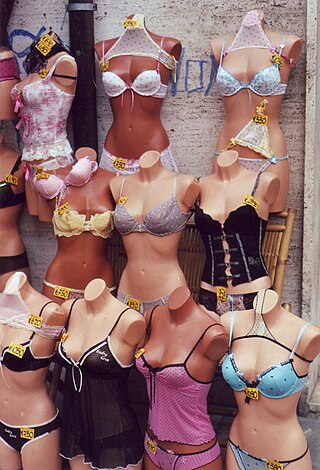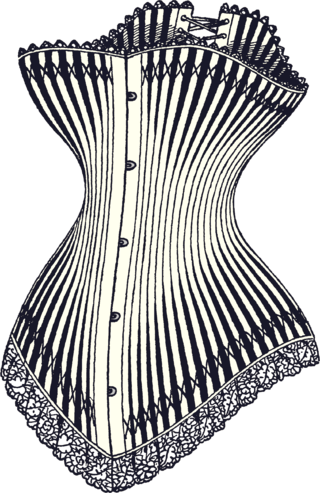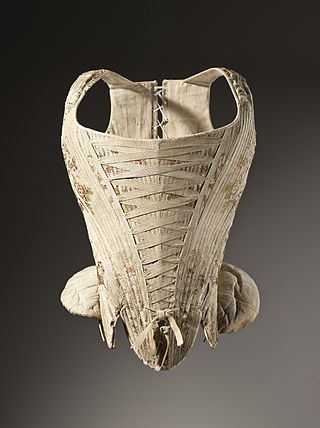Related Research Articles

Lingerie is a category of primarily women's clothing including undergarments, sleepwear, and lightweight robes. The choice of the word is often motivated by an intention to imply that the garments are alluring, fashionable, or both. In a 2015 US survey, 75% of women reported having worn "sexy lingerie" in their lifetime.

Fetish fashion is any style or appearance in the form of a type of clothing or accessory, created to be extreme, revealing, skimpy, or provocative in a fetishistic manner. These styles are by definition not worn by the majority of people; if everyone wears an item, it cannot have fetishistic, special nature. They are usually made of materials such as leather, latex or synthetic rubber or plastic, nylon, PVC, spandex, fishnet, and stainless steel. Some fetish fashion items include: stiletto heel shoes and boots, hobble skirts, corsets, collars, full-body latex catsuits, stockings, miniskirt, crotchless underwear, jockstraps, diapers, garters, locks, rings, zippers, eyewear, handcuffs, and stylized costumes based on more traditional outfits, such as wedding dresses that are almost completely see-through lace, or lingerie for men.

A corset is a support undergarment worn to hold and train the torso into the desired shape and posture. They are traditionally constructed out of fabric with boning made of whalebone or steel, a stiff panel in the front called a busk which holds the torso rigidly upright, and some form of lacing which allows the garment to be tightened. Corsets were an essential undergarment in European women's fashion from the 17th century to the early 20th century. In the 17th and 18th centuries they were commonly known as "stays" and had a more conical shape. This later evolved into the curvaceous 19th century form which is commonly associated with the corset today. By the beginning of the 20th century, shifting gender roles and the onsets of World War I and II led the corset to be largely discarded by mainstream fashion.

The corset is a supportive undergarment for women, dating, in Europe, back several centuries, evolving as fashion trends have changed and being known, depending on era and geography, as a pair of bodies, stays and corsets. The appearance of the garment represented a change from people wearing clothes to fit their bodies to changing the shape of their bodies to support and fit their fashionable clothing.

The Wonderbra is a type of push-up underwire brassiere that gained worldwide prominence in the 1990s. Although the Wonderbra name was first trademarked in the U.S. in 1955, the brand was developed in Canada. Moses (Moe) Nadler, founder and majority owner of the Canadian Lady Corset Company, licensed the trademark for the Canadian market in 1939. By the 1960s the Canadian Lady brand had become known in Canada as "Wonderbra, the company." In 1961 the company introduced the Model 1300 plunge push-up bra. This bra became one of the best-selling Canadian styles and is virtually identical to today's Wonderbra.

In women's clothing, a corselet or corselette is a type of foundation garment, sharing elements of both bras and girdles. It extends from straps over the shoulders down the torso, and stops around the top of the legs. It may incorporate lace in front or in back. As an undergarment, a corselet can be open-style or panty-style.

Cleavage is the narrow depression or hollow between the breasts of a woman. The superior portion of cleavage may be accentuated by clothing such as a low-cut neckline that exposes the division, and often the term is used to describe the low neckline itself, instead of the term décolletage. Joseph Breen, head of the U.S. film industry's Production Code Administration, coined the term in its current meaning when evaluating the 1943 film The Outlaw, starring Jane Russell. The term was explained in Time magazine on August 5, 1946. It is most commonly used in the parlance of Western female fashion to refer to necklines that reveal or emphasize décolletage.
Berlei is a brand of women's lingerie and in particular bras and girdles.

A foundation garment is an undergarment designed to impermanently alter the wearer's body shape, to achieve what some view as a more fashionable figure. The function of a foundation garment is not to enhance a bodily feature but to make it look more presentable.

The Warnaco Group, Inc. was an American textile/clothing corporation which designed, sourced, marketed, licensed, and distributed a wide range of underwear, sportswear, and swimwear worldwide. Its products were sold under several brand names including Calvin Klein, Speedo, Chaps, Warner's, and Olga.

Fashion in the years following World War II is characterized by the resurgence of haute couture after the austerity of the war years. Square shoulders and short skirts were replaced by the soft femininity of Christian Dior's "New Look" silhouette, with its sweeping longer skirts, fitted waist, and rounded shoulders, which in turn gave way to an unfitted, structural look in the later 1950s.

The history of bras is closely tied to the social status of women, the evolution of fashion, and shifting views of the female body over time.

A bandeau is a garment comprising, in appearance, a strip of cloth. Today, the term frequently refers to a garment that wraps around a woman's breasts. It is usually part of a bikini in sports or swimwear. It is similar to a tube top, but narrower. It is usually strapless, sleeveless, and off the shoulder. Bandeaux are commonly made from elastic material to stop them from slipping down, or are tied or pinned at the back or front. In the first half of the 20th century, a "bandeau" was a narrow band worn by women to bind the hair, or as part of a headdress.
A bra, short for brassiere or brassière, is a form-fitting undergarment that is primarily used to support and cover a woman's breasts. A typical bra consists of a chest band that wraps around the torso, supporting two breast cups that are held in place by shoulder straps. A bra usually fastens in the back, using a hook and eye fastener, although bras are available in a large range of styles and sizes, including front-fastening and backless designs. Some bras are designed for specific functions, such as nursing bras to facilitate breastfeeding or sports bras to minimize discomfort during exercise.

Underwear, underclothing, or undergarments are items of clothing worn beneath outer clothes, usually in direct contact with the skin, although they may comprise more than a single layer. They serve to keep outer clothing from being soiled or damaged by bodily excretions, to lessen the friction of outerwear against the skin, to shape the body, and to provide concealment or support for parts of it. In cold weather, long underwear is sometimes worn to provide additional warmth. Special types of undergarments have religious significance. Some items of clothing are designed as undergarments, while others, such as T-shirts and certain types of shorts, are appropriate both as underwear and outerwear. If made of suitable material or textile, some underwear can serve as nightwear or swimwear, and some undergarments are intended for sexual attraction or visual appeal.

Gossard is a Nottingham-based brand and manufacturer of women's undergarments and hosiery. Founded in the early 20th century in Chicago as H. W. Gossard Co., it expanded quickly, flourishing in the 1920s. As Associated Apparel Industries, Inc. it held a central position in its market in the 1930s. Amalgamated eventually succumbed to the poor economy in the United States during the Great Depression, but Gossard continues as a division of Courtaulds in Great Britain.

A bralette is a lightweight bra without an underwire, designed primarily for comfort. Bralettes are also sometimes worn as outerwear top, and are also designed as undershirts for girls developing breasts. The size of the bralette also differs from that of a bra: Instead of band width and cup size, normal clothing sizes are commonly used.

Chantelle is a lingerie brand belonging to the Groupe Chantelle, a French lingerie company founded in 1876 by François Auguste Gamichon.

Triumph International is a Swiss underwear manufacturer founded in 1886 in Heubach, Germany. The company's headquarters has been located in Bad Zurzach, Switzerland, since 1977, and it has branches in 45 countries. In addition to the Triumph brand, the company produces and distributes the products under the brands sloggi and AMO’s Style by Triumph.
Thousands of years of history provide evidence of the differing fashions, cultural norms, and artistic depictions regarding cleavage and clothes that accentuate or flaunt cleavage. From the absolute modesty of the 16th century, to the Merveilleuses Directoire dresses with their transparency, the décolleté has followed the times and is much more than a simple fashion effect.
References
- ↑ Silhouette – Page 1. Pastform.exofire.net (2009-03-19). Retrieved on 2011-05-14.
- 1 2 Francis, Peter (2006). A Matter of Life and Death, The Secrets of Shrewsbury Cemetery. Logaston Press. pp. 81–82. ISBN 1-904396-58-5.Account of Lobbenberg family who had members buried in the cemetery.
- ↑ Simcock, Sharon. (2009-11-02) BBC – Memories of a Shropshire Factory. BBC News. Retrieved on 2011-05-14.
- ↑ Here and There: Silhouette Little X Open Girdle. Brabarella.blogspot.com (2010-03-30). Retrieved on 2011-05-14.
- ↑ Shrewsbury’s Silhouette factory to be subject of a play « Shropshire Star. Shropshirestar.com (2009-03-19). Retrieved on 2011-05-14.